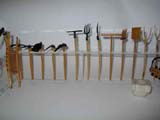

THE COUNTRY LIFE
The story of the society, of its usages, of its costumes from matera
are heritage of the peasant past and its people; as the all South of
Italy Matera has always linked its economy to agricultural work besides
the pastoral one. During the Bourbon time the South was divided into
large estates belonging to big land owners who ran them without introducing
the essential technological innovations able to increase the productivity
and reduce the toils and the work of peasants and farm labourers. This
lassitude culture, tied to a mere hope that the land had to be so magnanimous
and generous to "give" its fruits to those who had been cultivating
it all the year, had maintained also after and more than the unity of
Italy.
As regards for example the agricultural machines and the systems of
fields cultivation, the backward South peasant culture it's unquestionably
emphasized by the methodical use of equipments which are by now obsolete
in comparison to elsewhere; when the human and the animal driving force
were unwonted in the North of Italy; they were constantly used in the
South.
In this context the reproduction of models in scale of old agricultural
equipments used mainly between the 19th and 20th century in Matera and
its surroundings wants from one side to remember, to revive and show
the machines and the tools used by our grandfathers and great-grandfathers
and to the other side to make us reflect on sacrifices, on toil and
difficulties that our forefathers had to face every day to live from
the fruits of their work.
THE AGRICULTURAL EQUIPMENTS
Between
the 19th and 20th century the typical activities of peasant work were
carried out by wooden and iron means or made with both materials, these
were drawn by animals helped by man.
These means totally made of wood or with small iron components were
typical of the 19th century while in the 20th century they were bit
by bit replaced by totally metallic implements. Plows, harrows, rollers,
at first constructed on one's own according to empirical principals
of operation, which were handed down from our parents and amply wide-spread
were then or bought by Italian and foreign firms specialized in the
agricultural mechanical branch or reproduced by local artisans or blacksmiths.
Agricultural machines at the beginning heavy, not very functional and
subject to a constant wear and tear, were replaced by lighter, more
efficient and easy to handle machines; as for example the characteristic
"disk furrower", able to make furrows not deeper than 10cm.
into the earth, were replaced by the more modern mouldboard plow or
voltorecchi, which were thought to make regular and deeper furrows (20-30
cm when drawn by animals, and 40-50 cm when drawn by a tractor) and
to move the earth better.
The most commonly used woods to make agricultural equipments were the
hard ones like, the oak, the almond, the cherry, the pear, the walnut,
and the olive able to stand the common stress of furrowers and harrows;
instead woods like the aspen and the fir were used to construct the
vehicles beds and the guides. As regards the most commonly used metals,
we have to say that, even though the agricultural equipments manufactured
by big specialized firms were made of cast iron, steel, chrome plated
steel, vanadium steel, malleable iron, at local level the blacksmiths
produced them only by using malleable iron or for the furrowers colters,
in hardened steel.
The most useful equipments to cultivate the land were certainly the
furrowers; on the basis of the land type to be ploughed they used different
furrowers drawn by one or more mules. For example in very tilted lands,
they used the voltorecchi furrowers that allow, thanks to a system that
permitted the furrower topple from left to right, to move the earth
always towards the valley, this simplified and made the work less tiring.
Some of the furrowers allowed the colter adjusting or by more complex
mechanism, the colter moving towards left or right by considering the
furrow track.
The simple furrowers, as said before, were the result of the local craftsmanship
while those with more mechanisms were bought by the big firms which
manufactured agricultural products, these were especially Italian (Gardini,
Ridolfi, Tommaselli), Belgian (Mélotte), German (Sack, Eckert,
Eberhadt, Flother) and American. Taken into account the wide spread
illiteracy of that period and the uneasy pronunciation of foreign words,
the name brand of some foreign furrowers were translated into dialect;
that's why for example, the furrower model Brabant (brabantino in Italian)
made by Mélotte firm in Gembloux (Belgium) was named "B"
RBOND (rascal) in Matera and Melotto in the close Laterza (Ta) while
the furrower made by the German firm Floter for the South of Italy simply
became "L'ARET TEDASCK" which means the German furrower.
© Copyright
2005 Antonio Cosola
Vietata la riproduzione anche parziale dei contenuti di questo sito
senza la preventiva autorizzazione scritta dell'autore. Tutti i diritti
sono riservati.
Sito realizzato da
Sandro Cosola